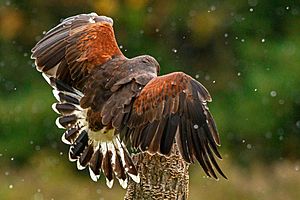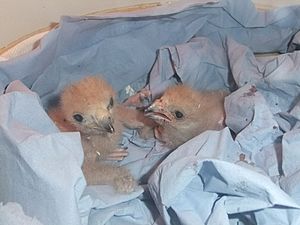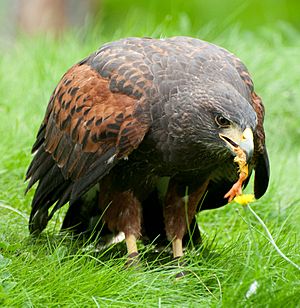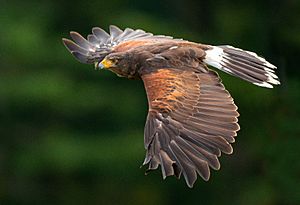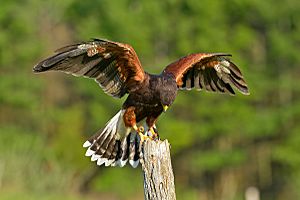Harris's hawk facts for kids
Quick facts for kids Harris's hawk |
|
|---|---|
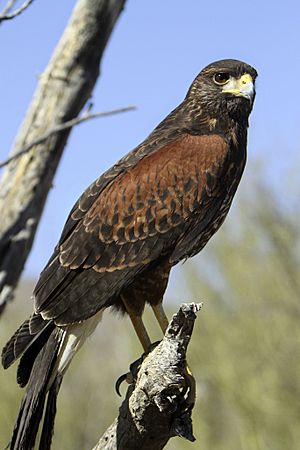 |
|
| Conservation status | |
| Scientific classification | |
| Genus: |
Parabuteo
|
| Species: |
unicinctus
|
| Subspecies | |
|
P. u. harrisi |
|
 |
|
| Distribution map of Parabuteo unicinctus | |
| Synonyms | |
|
Falco harrisii Audubon 1839 |
|
The Harris's hawk (Parabuteo unicinctus) is a medium-sized bird of prey. It is also known as the bay-winged hawk or dusky hawk. In Latin America, people call it peuco. These amazing birds live from the southwestern United States all the way south to Chile, central Argentina, and Brazil.
Sometimes, people report seeing Harris's hawks in Western Europe, especially in Britain. However, these birds are very popular in falconry, which is the sport of hunting with trained birds of prey. So, most of these sightings are likely birds that have escaped from captivity.
The name "Harris's hawk" comes from John James Audubon. He was a famous bird expert who named the bird after his friend and supporter, Edward Harris. The scientific name, Parabuteo unicinctus, also has a meaning. Para means "beside" or "like" in Greek, and buteo is a Latin word for a type of buzzard. Uni means "once," and cinctus means "girdled," which refers to the white band at the tip of the hawk's tail.
Harris's hawks are special because they often hunt together in groups. Most other birds of prey hunt alone. This social behavior shows how smart they are. It also makes them easier to train, which is why they are so popular for falconry.
Contents
What Does a Harris's Hawk Look Like?
The Harris's hawk is a medium-large hawk. It is bigger than a peregrine falcon but smaller than a red-tailed hawk. These hawks are usually about 46 to 59 centimeters (18 to 23 inches) long. Their wingspan is typically around 103 to 120 centimeters (41 to 47 inches).
They have brownish feathers, with reddish shoulders and tail feathers. The tail feathers have a white base and a white tip. Harris's hawks show sexual dimorphism, which means males and females look a bit different. Females are about 35% larger than males.
In the United States, male Harris's hawks weigh around 701 grams (1.5 pounds) on average. Females are heavier, averaging about 1,029 grams (2.3 pounds). They have dark brown feathers with chestnut-colored shoulders, wing linings, and thighs. Their legs are long and yellow, and they have a yellow cere (the waxy part above the beak). When they make sounds, their calls are very harsh.
Young Harris's Hawks
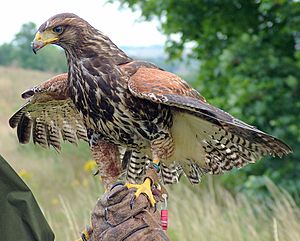
Young Harris's hawks, called juveniles, look different from adults. Their feathers are mostly streaked with light brown or yellowish-brown. This makes them appear much lighter than the dark adult hawks.
When they fly, the undersides of their wings are light-colored with brown streaks. At first glance, they might not look like adults. However, they still have the same chestnut-colored feathers on their shoulders, which helps to identify them.
Where Do Harris's Hawks Live?
Harris's hawks live in open woodlands and semi-desert areas. They can also be found in marshes that have some trees, like mangrove swamps in South America. These hawks do not migrate; they stay in the same area all year round.
They like places with scattered large trees or other tall features. These spots provide good places to perch and build nests. This includes power poles, edges of woodlands, dead trees, and large rocks.
The number of Harris's hawks in the wild is going down. This is mainly because their habitat is being lost. However, sometimes they can adapt and move into areas where humans have built things.
How Harris's Hawks Behave
Harris's hawks live in stable groups, which is unusual for birds of prey. These groups typically have 2 to 7 birds. There is a pecking order, or dominance hierarchy, within the group. The adult female is usually in charge, followed by the adult male, and then the younger birds from previous years.
These birds not only hunt together, but they also help each other with nesting. No other bird of prey is known to hunt in groups as regularly as the Harris's hawk.
What Harris's Hawks Eat
The diet of the Harris's hawk includes small animals. They eat birds, lizards, small mammals, and large insects. Because they often hunt in groups, Harris's hawks can also catch larger prey.
Sometimes, they can even take down prey weighing over 2 kilograms (4.4 pounds). This might include adult jackrabbits, great blue herons, or even half-grown wild turkeys. The desert cottontail rabbit is a common prey for them in the northern parts of their range. These rabbits usually weigh 800 grams (1.8 pounds) or less.
Because they hunt large prey often, Harris's hawks have bigger, stronger feet with long talons. Their beak is also larger and more hooked than most other raptors of similar size.
How Harris's Hawks Hunt Together
Most raptors are solitary, meaning they live and hunt alone. They only come together to breed or migrate. But Harris's hawks are different. They will hunt in cooperative groups of two to six birds. Scientists believe this behavior helps them find enough food in the desert, where prey can be scarce.
In one hunting method, a small group of hawks flies ahead to scout for prey. Then, another hawk flies ahead to scout, and they keep doing this until they catch something, which they then share. In another method, all the hawks spread out around the prey, and one bird scares it out into the open. Groups of Harris's hawks are more successful at catching prey than single hawks. Groups of two to four birds have about a 10% higher success rate for each extra hawk.
Harris's Hawk Reproduction and Life Cycle
Harris's hawks build their nests in small trees, shrubs, or cacti. Their nests are often compact and made of sticks, plant roots, and stems. They usually line the nests with leaves, moss, bark, and plant roots. The female hawk does most of the nest building.
They typically lay two to four eggs. The eggs are white to bluish-white, sometimes with light brown or gray speckles. The eggs hatch in 31 to 36 days. When the nestlings are born, they are light brown. After five or six days, they turn a rich brown color.
It's common for three hawks to attend one nest: two males and one female. The female does most of the incubation, which means sitting on the eggs to keep them warm. The young hawks start exploring outside the nest at about 38 days old. They begin to fledge, or fly, when they are 45 to 50 days old. The female might breed two or three times in a single year. Young hawks can stay with their parents for up to three years, helping to raise younger brothers and sisters.
Nests can be attacked by predators like coyotes, golden eagles, red-tailed hawks, great horned owls, and flocks of common ravens. These predators might be too strong for the Harris's hawk group to fully defend against. There are no known reports of adult Harris's hawks being attacked by predators in the United States. This means the Harris's hawk is considered an apex predator in its environment. In Chile, black-chested buzzard-eagles are likely predators of Harris's hawks.
Harris's Hawks and Humans
Harris's Hawks in Falconry
Since around 1980, Harris's hawks have become very popular in falconry. They are now the most popular hawks used for this sport in the Western world (outside of Asia). This is because they are one of the easiest hawks to train and are very social.
Trained Harris's hawks have been used to help control unwanted pigeon populations. For example, they have been used in London's Trafalgar Square and at the tennis courts at Wimbledon. Falconers in the United States also use trained Harris's hawks for bird abatement at places like resorts and industrial sites.
Harris's Hawks in Art
The famous artist and bird expert John James Audubon included the Harris's hawk in his well-known book, The Birds of America. He called it the "Louisiana Hawk." The original painting is now kept at the New York History Society.
See also
 In Spanish: Busardo mixto para niños
In Spanish: Busardo mixto para niños



